Media Monitoring: The Ultimate Guide
Media monitoring is crucial for safeguarding your reputation, understanding your target audience, and making informed, data-driven PR decisions. In this comprehensive guide, we examine the evolution of media monitoring in recent times, the impact of AI-powered tools on PR professionals, and strategies for ensuring comprehensive media monitoring across various channels. Whether you’re facing a crisis, tracking competitors, or measuring brand impact, we’ll show you how to build a media monitoring strategy that keeps you informed, aligned, and in control.
It feels like you’ve been punched in the gut.
Your boss is standing in front of you—furious—demanding to know how you let this happen…
An industry report slamming your organization has been circulating since the beginning of the week and your competitors have been laughing it up, splashing it all over social media.
It’s been snowballing out of control, and you, the communications expert, haven’t done a thing.
How could you have when you’re just finding out now?
You feel sick.
A million thoughts and questions rush through your head. A couple of standouts: “How did I get here?” Better still, “How do I make sure this NEVER happens again?”
The answer – in short – is media monitoring. And preventing situations like the one described above is really just the tip of the iceberg of what media monitoring can do for your organization, and your career as a communications professional.
This page is going to delve deep into media monitoring
We’re going to talk about everything from what it is and what it’s used for, to how you can make it work best for you and your organization.
Media monitoring, in some form or another, has been around since the 1850s. Ranging from free online options to automated tools to managed services, media monitoring can be as basic or as advanced as necessary.
And this is just the beginning.
When you’re done reading, you may not be an expert in the art and science that is media monitoring, but you’ll be well on your way.
Here’s how we’re going to break it all down:
So dive in, come up for air when you need to, and let’s all get to know media monitoring a little better.
Media monitoring: What is it and why is it important?

What was once a literal cut-and-paste job – where workers scoured newspapers and magazines for mentions, cut out the articles, and pasted them into physical clipbooks – is now a modern and technologically advanced practice; it uses machine learning, sophisticated algorithms, and powerful processors to track, gather, and organize mentions from across the media landscape. Sure, the premise remains the same – to track a particular topic through the media – but the process has become infinitely more refined.
We’ve traded in our scissors for software.
Definition: Media monitoring is listening to who’s saying what about your brand, your competitors, your industry, and any other topic that’s important to you and your operations.
There it is.
Look at the first part of the definition. Media monitoring is listening. Couldn’t agree more. It’s keeping your eyes and ears open to the conversation around your brand, a conversation that is happening at all times everywhere around you, on all channels and at all volumes.
Pretty important, no?
But different organizations have different wants and needs when it comes to media monitoring.
There are many types of media monitoring solutions available, and broadly these fall into three categories:
- Free or cheap options
- Paid media monitoring tools
- Premium monitoring services.
We’ll cover these categories in a lot more detail later on, but for now it’s good enough that you just know they exist.
#MediaMonitoring is listening to who’s saying what about your brand, your competitors, your industry, and any other topic that’s important to you.
Where to look
With the avalanche of everyday information, it can sometimes seem like there’s no way you’re ever going to gather every bit of your organization’s coverage. The good news for you is that if there’s a relevant mention out there, the best media monitoring solutions will find it for you. Here’s where they look:
Online
The world lives on the internet now. The fact is, if you’re at all serious about tapping into the conversation and contributing to/taking hold of the message, then you need to be watching the web, from the biggest online news outlets to the smallest blogs.

Modern media monitoring hasn’t forgotten its roots. Newspapers and magazines still make up a good portion of press coverage, and, depending on your target audience (we’ll talk about this later), they might just be where you want your message appearing most of all.
Broadcast
Despite the downturn in cable subscriptions, television still holds much sway over public perception. Likewise, you ignore radio at your peril, seeing as it’s the third-most powerful medium in the United States, reaching 54% of the population daily in 2017. And good media monitoring software employs cutting-edge speech-to-text transcription, so you can trust you won’t miss that priceless soundbite.
Social media
Social content continues to explode. If your audience isn’t on social media, chances are you don’t have an audience. What social media monitoring allows you to do is listen to, and involve yourself in, the conversation around your brand. You can discover which pieces of content and coverage are resonating; and you can identify those all-important social media influencers. Even if social media isn’t the purview of PR, every good communicator should have their ears perked firmly in its direction.
Five reasons to media monitor
Media monitoring is crucial to PR success.
There! We said it.
But really, it is.
The reason being that, when it comes to public relations, you can’t be in the dark about anything. You absolutely need to know what’s going on, not only with how your own organization is being presented and perceived, but with everything around you; you need to know what your competition is doing and where your industry is going.
And media monitoring provides that knowledge.
Here are a few specific reasons to monitor:
1. Understanding your target audience
When you monitor your market, you come to understand your target audience (told you we’d get to discussing this).
And by understanding your target audience, you can better relate to them and better communicate with them…which is pretty much the whole point of this PR thing, right?
It’s about knowing how they speak, understanding the language they use when they talk about the things that matter to you. When you monitor your market, you learn what they care about and what they don’t care for at all; you learn what they think about your competition and what they love or hate about your own product.
All this is to say, when you monitor your market, you can more effectively develop your communications so that you’re speaking directly to the people that matter to you.
2. Brand monitoring
Your reputation is what you trade on. And it’s only as strong as how your brand is perceived.
Now, how do you think you learn how your brand is perceived? Gold star if you said “media monitoring.”
While media monitoring can help identify potential crises and mitigate damage by allowing companies to respond quickly and intelligently, it is also essential in creating an effective reputation management plan, allowing you to be proactive rather than just reactive.
And no longer is it just text mentions that you can and need to monitor. You know that images dominate the media, so it only makes sense that you should monitor your brand for visual coverage too. AI-powered image monitoring, exclusively available from Agility PR Solutions, lets you literally get the full picture of coverage.
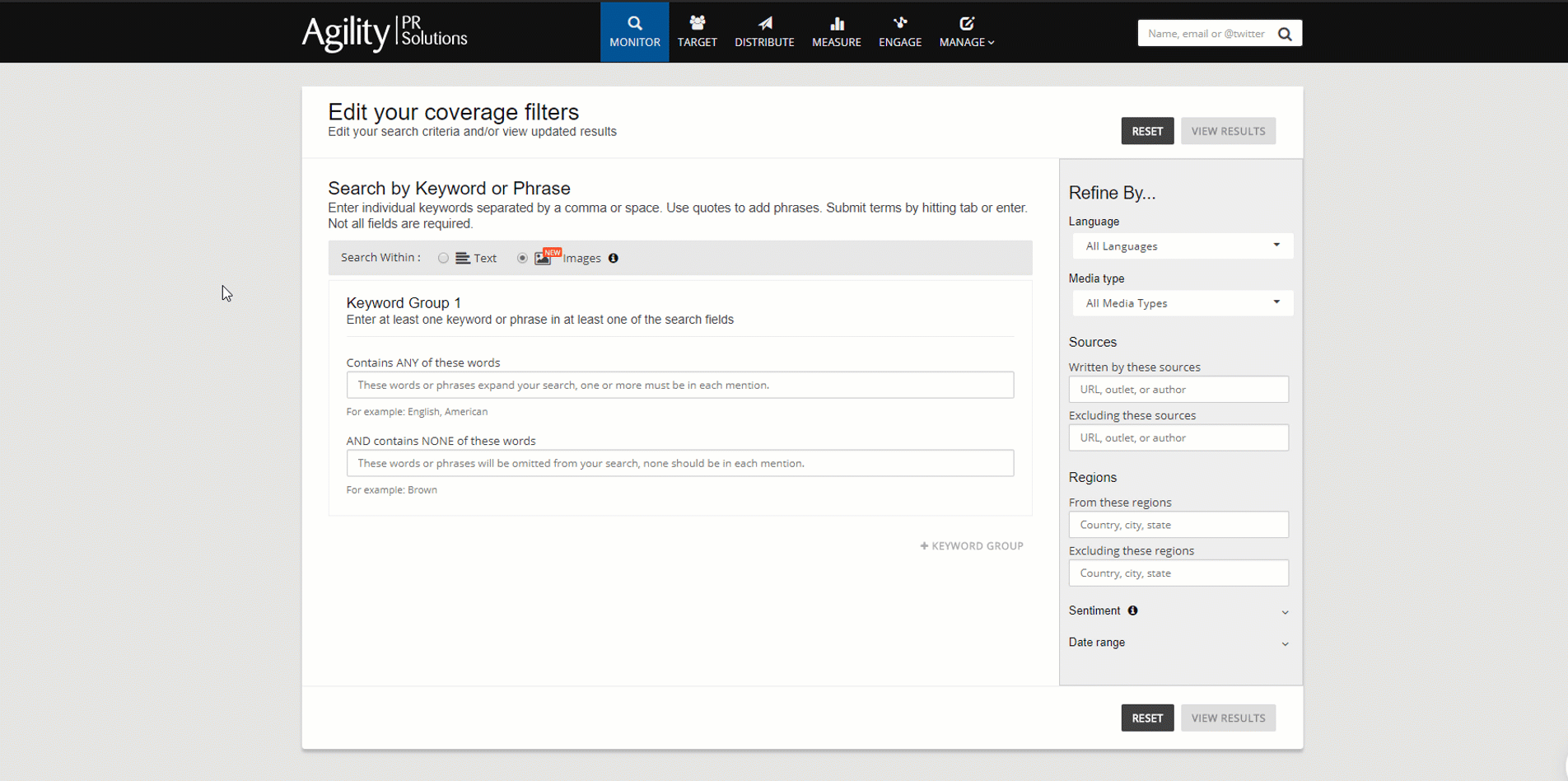
When you know what people are saying about you, you can respond thoughtfully, thereby increasing your transparency, your authenticity, and your positive relationships, all of which in turn leads to – could this actually be true?! – a better reputation.
3. Risk mitigation
No organization is immune from risk; it’s a fact of doing business. But whereas understanding and mitigating potential risk is usually the responsibility of several internal departments, hiring a media monitoring provider can centralize the workload by:
- Identifying supplier-related risk by monitoring media mentions of new/existing suppliers
- Monitoring potential risk from changes to the legislative landscape you operate within
- Keeping an eye on what competitors are saying to the market, and, in turn, what market perception is of them
4. Evaluating your efforts
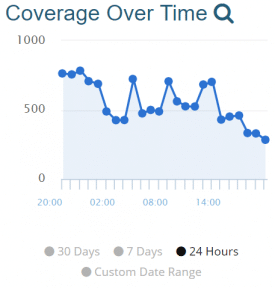
A coverage over time chart from the Agility media monitoring dashboard
There comes a time in every professional’s life when they need to take a good, hard look at the work they do and assess their performance.
In the life of the PR pro, that day just so happens to come at the end of every campaign, if not more frequently.
Because if what you’re doing isn’t working, your boss/clients are going to want to see a change.
Media monitoring lets you know if your efforts are turning into results. Only by tracking your coverage will you know if you’re getting coverage; only by monitoring the media will you know if you’re earning it.
Evaluating your efforts is crucial in any role, but PR and comms pros are nothing if not competitive and ambitious – we know you’d rather be learning and evolving than falling behind in any way.
5. Identifying journalists and influencers for outreach
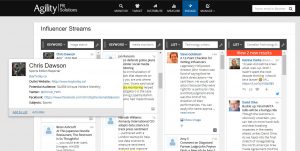
Monitor journalists in Agility’s Influencer Streams dashboard
When you monitor, you learn which journalists and influencers you should target.
If you find one who writes extensively on your competitors, you can reach out and show them what you do differently. If you find one who is not fully on your side, you can reach out to them and change their mind; the idea is that, in turn, they’ll change the minds of their readers.
Monitoring can identify:
- Journalists who often write about your market or industry and whose opinions carry clout with your target audience.
- Individuals with large social media followings whom you can leverage to gather product feedback, or influence to review or endorse your offering.
- Detractors who could spread negative or misleading information about you.
It’s imperative to know who’s saying what – and who’s listening to them – before reaching out with your own contribution to the conversation.
Who should be using media monitoring
If you work for an organization that has interactions with the public (perhaps as customers, investors, donors, employees, constituents, volunteers, neighbors, anything really!) and you care about reputation and public perception, then you need a media monitoring tool in your kit.
Likewise, if you’re forward thinking, and want to spot the opportunities and risks that could change everything for your organization, then tracking what’s being said about your industry, your competitors, and the issues your organization cares about is a must – and a media monitoring service can help.
If you have interactions with the public and you care about reputation, then you need a #MediaMonitoring tool in your kit.
Let’s consider a few scenarios, shall we?
Startups and small- to medium-sized enterprises (SMEs)
Even in this day and age, positive media coverage is still the ultimate credibility marker and can be a powerful growth hack for your business if properly leveraged. Earned media can draw a lot of attention to a company, helping to bring in new prospects, customers, investors, and talent.In the words of another author, “…having articles or stories written about your company helps build credibility about your product or service. A story in the paper is like an unspoken third-party endorsement for your business, as this is not paid advertising, but rather earned advertising.”
But here’s the thing – how will you collect and leverage this awesome credibility sauce if you aren’t regularly keeping track of every online publication, newspaper, journal, magazine, and blog that might mention you?
Startups and SMEs work hard to promote their brands, and can benefit from keeping track of what media coverage they earn from these efforts. This can help prove the value of time spent on PR and marketing.They also need to be responsive to their audience and play a role in shaping public perception in order to grow. An article from Piktochart nailed it, stating, “There IS a conversation about your brand happening out there, the only question is what are you doing about it?”
Not all startups can afford a robust media monitoring service; fair enough. But even they have some free options available (at least for monitoring online mentions). As others have said, “Staying on top of your brand’s image is essential for any growing business…”
Large businesses
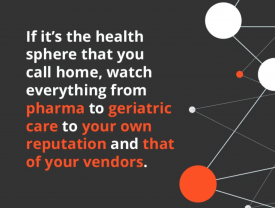 Naturally, larger businesses are in a bit of a different boat than startups and small- to medium-sized enterprises, but their media monitoring needs are no less important.
Naturally, larger businesses are in a bit of a different boat than startups and small- to medium-sized enterprises, but their media monitoring needs are no less important.
Large businesses generate a lot of media coverage and online mentions, but much of that content is not relevant to their overall success or day-to-day operations. They need help separating the noise from the important news. Big businesses also need to be able to demonstrate the ROI of their PR efforts, benchmark their performance, and communicate that information clearly with key stakeholders.
Whereas a small business may be able to set up an automated monitoring service and sort the relevant mentions from the noise themselves, big businesses typically prefer to receive curated (managed) media monitoring reports that focus on only the most relevant pieces.
There are so many reasons for large businesses to invest in a robust media monitoring service:
- Public relations
- Risk management
- Crisis mitigation and management
- Marketing
- Sales
- And more…
Let’s dig into a few examples:
Public relations
Large companies invest a lot of money in public relations. Whether it’s with PR firms or in building out their own in-house communications teams, they are increasingly looking for proof that their money is being well spent. Media monitoring and analysis can help answer that question – and seeing what works can help direct future efforts and investments in PR.
Risk management
When a business reaches a certain size, there is almost inevitably some degree of public affairs risk built into the business model.
Imagine the real-estate developer whose hundred-million-dollar build is threatened by community backlash over gentrification… yet chooses not to pay attention to influential blogs and community publications in the area.
Crisis mitigation management
We’ll touch on this in more detail further along, but for now let’s just say this:
How a business responds to a crisis can be the difference between A) a disastrous hit to their reputation (sales, stock price, ability to attract talent, etc.) and B) cementing their role as a responsible leader in their industry.
How a business responds to a crisis can be the difference between A) a disastrous hit to their reputation (sales, stock price, ability to attract talent, etc.) and B) cementing their role as a responsible leader in their industry.
But that ability to respond effectively depends on several factors: the response must be timely; it must address the public’s concerns; it must correct any damaging misinformation that has begun to circulate in the wake of the crisis. And guess what? All of these factors start with monitoring the media and public discourse surrounding the event in question.
Monitoring can help you evaluate what your company’s public image was before a crisis, so you can gauge how to focus your crisis rehab efforts and know when you’re getting back on track.
Advocacy groups, associations, and the not-for-profit sector
The organizations in this category are driven primarily by the specific issues that are important to them and their members, constituents, or volunteers.
Although smaller NFPs may not have the resources to pay for a professional media monitoring service, they can still dip their toes in the water using some of the free options outlined in this document… and they should! Seriously, do you think public opinion might be important to an organization whose very lifeblood is the goodwill of donors and volunteers? Of course it is!
Likewise, advocacy groups, associations, and NFPs can monitor the coverage of issues they care about in order to be more prepared and effective in the pursuit of their missions.
Take for example an organization whose mission is to protect the environment in a specific region. Beyond monitoring their own coverage, should they pay attention to news about a nearby industrial operation? About business and real-estate development in the region? About environmental protection legislation in their country, region, or municipality? Yes, yes, and yes.
Media monitoring can warn an organization of outside opportunities, risks, and threats. Not only can they use media monitoring to stay informed, they can leverage news of impending risk in order to rally support, donations, and mobilize their community with news of the urgency of the cause. In turn, monitored coverage of the public outcry in support of a cause can provide these organizations with some much-needed political leverage.
Government and public administration
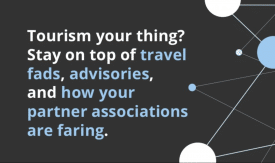
Organizations in this category tend to be publicly funded and subject to a great deal of scrutiny. For government and public administration bodies, having the public’s confidence or disdain makes a world of difference. These organizations absolutely must be attentive to public sentiment and the ways they are being portrayed in the press.
Similar to the previous category, government and public administration organizations can leverage media monitoring and analysis for:
- Issues management
- Reputation management
- Risk management
- Crisis management
- Future planning
Want to dig further into the details? Check out our article Why governing bodies should use media monitoring and analysis.
PR and communications agencies
This is one group that can really leverage media monitoring to their advantage. In many cases, these agencies are hired to raise a brand’s profile or manage perceptions.
It should come as no surprise then that a public relations or integrated marketing and communications agency would need to monitor media coverage of their clients. Monitoring their clients’ coverage allows these agencies to benchmark earned media, track the success of their campaigns, and stay on top of any negative publicity in need of a response.
Growing comms and PR agencies also need to acquire new clients, and part of how they how they can demonstrate the value of their services is by showing examples of positive coverage they’ve earned for their other clients. Monitoring and collecting these “clippings” can help bring some very persuasive proof to a pitch!
Agencies can also use monitoring very effectively to seek out potential clients who are getting some coverage but could be doing better. Planning to reach out and pitch them? How about starting with some research on how they have been covered in the past, so you can start speaking intelligently about how they could improve their public relations output with your help.
Nothing like sounding smart to clients and prospects!
What to monitor
“I know media monitoring’s important, but where do I start?”
It’s something we hear every day. And we get it.
With the information avalanche cascading over you every single minute, it can be overwhelming. But there is a way to weave your way through it all and only listen to the things that matter. And a good media monitoring tool will help you do that.
The way most media monitoring tools work is with keywords. You (or the media monitoring company, or a combination of the two of you) compile a list of keywords that you think worthy of watching. Then you watch.
But this can quickly get out of hand, especially if the tool you’re using allows for unlimited keyword monitoring (like we do).
That’s why it’s important that you remember one thing – and I’m going to get you to repeat after me here – “I do not need to monitor everything.”
Buuuuuut, that being said, there are some things that you absolutely should. That’s what this section is all about.
1. Monitor yourself
This one is probably a bit obvious, but it bears saying: you need to monitor the media for mentions of your own organization.
That includes all known spellings and nicknames and short versions; if McDonald’s ignored mentions of Micky D’s, oh boy! they’d miss a lot.
At its most basic, monitoring yourself lets you know – and prove – that you’re getting earned media coverage in the first place. After all, if a tree falls in the forest…
It also lets you know who’s talking about you and what they’re saying. Now, these ones are big.
As for the “who,” if you know who your biggest supporters and detractors are, you can target them when it comes time to spread good news about yourself. For the “good guys,” it’s important to keep them in your corner; for the “bad guys,” do your best to change their minds.
As for the “what,” well that’s just elementary: how can you respond to something if you don’t know what that something is?
A little gold nugget from our SlideShare Taking Control With Media Monitoring: Tips for the Modern PR Guru: “When you know who is saying what—and where— about the topics that matter to your organization, you give yourself an edge. When you don’t know, you’re at the mercy of your competition.”
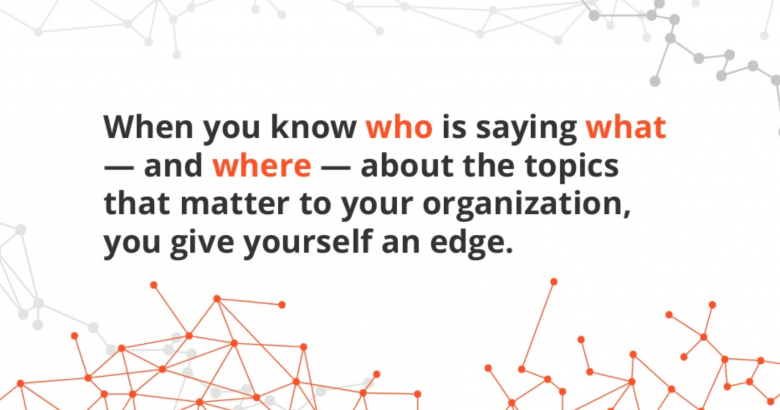
And despite what you’ve heard since you were in short pants, there is such a thing as bad publicity. When your name gets dragged through the mud, wouldn’t you rather know about it so you can address it? Likewise for when the publicity actually is good – if you know about it, you can exploit the nice feelings and promote the heck out of the piece.
Monitoring yourself also opens the door to the wonderful – and, to be honest, necessary – world of benchmarking.
When you start to listen, you’re able to track the coverage you’re getting. As the months and quarters and years roll by, you’re then able to compare your current levels to past performance. This is how you know if you’re improving, if you’re furthering your brand’s goals, and evolving as a communications professional.
And benchmarking can be applied to many different aspects of monitoring:
- Overall coverage over time
- Share of voice
- Spokespeople quotes
- Key messages conveyed
- Instance of favorable vs. unfavorable mentions
- And many, many more!
It’s all about being in control. When you monitor yourself, you gain the knowledge you need to better do your job. What’s that quote? First you get the knowledge, then you get the power, then you get the control over your branding and positioning. That’s definitely it.
But what about those organizations that feel they don’t get enough earned media coverage to warrant monitoring themselves? To them we say, media monitoring has a lot more uses than just tracking your own coverage; there’s a whole world out there you need to be tuned into.
2. Monitor your competition
Whether you’re an industry newcomer or an industry leader, you’re not alone in your space.
If you are that newcomer, you know that even the smallest fish in the pond has competitors, and the best way to grow big like them is to stay on top of their movements and take advantage where you can.
If you’re that leader, how are you going to make sure you stay on top? By keeping abreast of the movements of those who want to take you down, that’s how.
Dr. Gerhard van Wyk, business analyst and professor of marketing management, lays it out plainly: “A precise understanding of your competitor’s strengths and weaknesses is an important prerequisite for developing a strategy to compete against it.”
Competitive analysis is a pillar of any successful organization. If you don’t know what your industry rivals are doing – what products they’re launching, what executives they’re hiring, what their spokespeople are saying – you’re operating in the dark.
Media monitoring turns on the light.
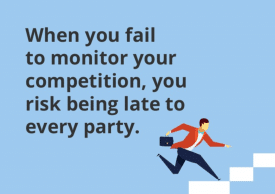
3. Monitor your industry
If you’re too humble to monitor yourself and too shy to monitor your competition, please, please at least monitor your industry.
As the great Mark Cuban said, “The first step (to business success) is to learn more about your industry than anyone in the world.”
The bottom line is that your industry is where you live.
“Understanding your industry is essential to effective strategic positioning.” – @MichaelEPorter
If you’re too small to garner much coverage, fine. If your only other competitor is just as small, good for you. But there is no reason to not do everything in your power to learn about and stay on top of your industry.
And media monitoring is the first step.
4. Monitor your suppliers and vendors
Here’s one you may not have thought of: how about keeping track of the companies you partner with?
Like we outlined in the risk mitigation section above, no organization is immune from risk. And the more partners you have, the more exposed you are. When one of your suppliers or vendors is found guilty in the court of public opinion, chances are your organization will be found guilty just by association.
Media monitoring can save you from that fate.
Before you enter into a partnership with a new supplier or vendor, use your media monitoring tool to look into their past coverage. You might be surprised how many skeletons are there waiting to be uncovered.
This is about protecting your brand value. You’ve worked exceptionally hard to build and maintain your good reputation; don’t risk tarnishing it by neglecting to vet a partner before doing business with them.
Same goes for current partners. By monitoring their coverage, you put yourself in a position to get out in front of any news that could potentially damage your own brand.
We know that risk is a fact of doing business, but with media monitoring you reduce it and take back some of the control.
Media monitoring for crisis situations
There comes a time in the life of every business when a public relations crisis surfaces. How the PR professionals involved handle this crisis can determine whether the company sinks or swims.
professionals involved handle this crisis can determine whether the company sinks or swims.
It’s not hard to remember examples of big businesses being caught flat-footed in the face of crisis. What examples come to mind for you?
The clothing company taking days to respond to tragic news from their factory in Bangladesh…
The energy company bumbling into a massive PR crisis when their wellhead started pumping 62,000 barrels of oil per day into the Gulf of Mexico…
What happened in these moments? Did these companies know there was a massive media story building up around their crisis and simply choose not to respond? Or were they not monitoring the coverage to begin with?
Poorly handled, news stories like these can have a crippling effect on a company’s reputation, stock price, and future ability to do business. Well monitored and managed, a company has a chance to respond effectively and shape the public narrative around their crisis.
Let’s break down how media monitoring can be used at the various stages of crisis management.
When you monitor, you give yourself the chance to take control of the message #MediaMonitoring
Being prepared before a crisis
Sure, you can sit back and hope for the best…but you need to prepare for the worst. That’s how you want to approach crisis management. You want to start creating a plan for your organization’s crisis response strategy when everything is going well, not when everything is blowing up.
More than just creating a plan, many organizations schedule a regular review of their crisis response strategy and update it to account for any changes in public opinion or brand reputation.
Media monitoring is not just about tracking one’s own coverage – you can learn a lot by paying attention when a competitor experiences a crisis. Take special note of how they handle the crisis, how they talk about the situation, and who covers the story. You can take those key learnings and build them into your own crisis plan.
Another way you can prepare for crisis is by using monitoring to understand and benchmark your current brand perceptions (including regional differences).
Media monitoring can also help identify potential surrogates – third party authorities and influencers who can champion your organization, even when you’ve made some mistakes.
Listening during a crisis

When the “stuff” hits the fan, the PR pro wants to be the first to know. For this they rely on real-time media monitoring with alerts to notify them of important coverage of their organization.
Before they can respond, PR pros need to know as much about the situation as possible, including what is being said about their organization or client(s), and who is saying it.
Research has consistently shown that listening is critical for communication and conflict resolution, especially during a crisis. Consumers want to make sure their voices are heard, especially when there’s a problem, so make sure you hear them.
From Forbes: “Listen to the people who are complaining. It is very important to try to understand what is making people angry. Anger hinders communication, and the person you are addressing will not listen to your message until they have had their say.”
A properly set up media monitoring program will help catch the news quickly and give you the advantage of a few precious minutes so you can craft a counter-narrative and get in front of the story before it gets out of hand.
Brand rehab after a crisis
Beyond informing that initial response, monitoring the conversation around a crisis will reveal what a brand can to do afterward to make things right and restore their tarnished reputation.
Once the storm has passed, it’s tempting to want to put a crisis behind you. But while operations have returned to normal, the truth is your company now exists in a new normal. How do you navigate this territory? Here are three key questions to ask yourself as your brand recovers:
- How bad is it?
- How can we rebuild?
- What have we learned?
The things you learn from monitoring the coverage can help answer these questions and pave the way forward.
Choosing a media monitoring provider
So, you’re thinking of getting started with media monitoring, or perhaps switching providers. Good for you, but where do you start?
If you’d like to talk to someone and get a personal consultation, drop us a line and one of our media monitoring experts can help sort through your requirements and help you find the right solution for you (even if it isn’t us). They can talk to you about your wish list of features, help you sort must-haves from nice-to-haves, and come up with a plan that can evolve along with your needs.
Not ready to talk to someone? That’s OK – just keep on reading.
Naturally, there are a lot of factors to consider. A good way to start is by considering your monitoring budget and needs. You’ll have to choose between:
- Free or cheap options
- Paid media monitoring tools
- Premium media monitoring services (where media analysts do all the work for you)
Free or cheap media monitoring options
If you’re absolutely broke but are still intent on getting started with monitoring, we salute your initiative!
Consider setting up some Google Alerts to monitor coverage in online news and blogs. Google News Downloader, for its part, gives you a way to download articles for your records.
As free tools go, these are great, but be warned that the results you see will be bare-bones and you might even miss some mentions; we’ve heard that Google Alerts scrapes sometimes as little as 30% what paid-for tools and services do.
You can augment that with some social media monitoring via Hootsuite’s free plan or similar free social media monitoring options from other providers.
In both cases you’ll have to decide what keywords to monitor for, so make sure to check out our DIY Media Monitoring Guide for some advice on how to get started.
Paid media monitoring tools
If you have a bit of a budget to work with, that opens a lot of options for you. When we say “media monitoring tools” here, we’re pretty much referring to cloud-based software tools that you can use to run your own media monitoring program. Premium, ‘done-for-you’ options are covered in the next section.
A media monitoring tool is one that you set up (usually with the help of the provider) and maintain yourself. It includes a dashboard, the option for you to receive automated briefs and alerts, and integrated reporting capabilities that make it easy to share the results of your media monitoring efforts among stakeholders.

Topic coverage report from Agility media monitoring tool
It’s great to have presentation-ready charts to add to your reports or to highlight for executives. Better still, reporting on sentiment and coverage-over-time also helps you figure out what’s working (or not) so you can evolve as a communicator and demonstrate the business impact of your PR efforts.
Compared to the free and cheap options mentioned above, a paid tool should surface a lot more relevant coverage and will likely be searching a broader range of sources. A little less informative than a media monitoring service, but much more robust than a free online tool, this is the solution that Goldilocks chose.
The CAPTURE package from Agility PR Solutions includes a media monitoring tool with all of the features mentioned here, and more. It even includes access to a massive and reliable database of influencers and media contacts, plus an easy-to-use platform for connecting with them.
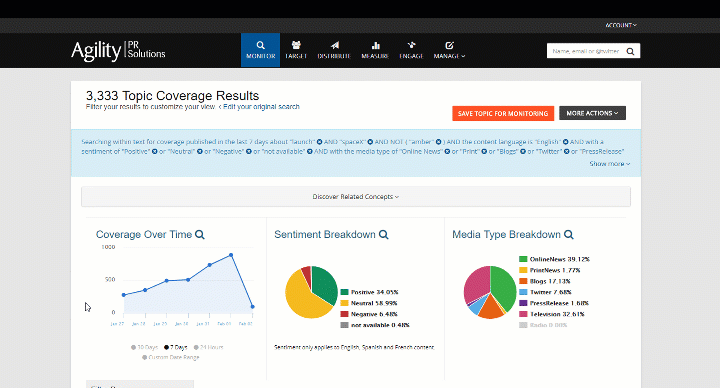
Premium media monitoring services
When your needs are a little more extensive, it helps to have a personalized, fully managed service at your disposal, a provider who can be a partner rather than just a vendor.
If you’re working for a large organization that generates a lot of media coverage, or has complex monitoring needs, a managed media monitoring service will be the best fit. You fit into this category if…
- You need someone to help separate the wheat from the chaff
- You need someone to create custom reports that exactly meet your needs
- You don’t want to trust sentiment analysis to a piece of software
- You want advanced analysis and measurement
- You care about quality of coverage, not just quantity
Getting this just right takes a human touch.
Agility PR Solutions’ ILLUMINATE package provides exactly that. Our media analysts set up and fine-tune keyword searches, curate executive-ready daily briefs, add context and sentiment insights in a way that only a human can, and make sure you’re delighted with every report and media brief delivered. That’s the big difference: your reports are human curated.
The difference between this and an automated tool is the level of analysis you get out of your monitoring. Whereas an automated tool will provide you with the quantity of your coverage, a managed service also lets you know the quality. And when you know quality, you can much more easily measure your PR efforts and connect them to your organization’s business goals.
It’s all about understanding the unique communications needs, challenges, and goals of your organization, and having a media monitoring solution to help you meet them.
Among the three types of media monitoring solutions, this is the Cadillac.
Read our client success stories to see how a curated media monitoring service can help an organization like yours.
Scratching your head? Still trying to understand the difference between a self-service media monitoring tool and a full-service curated media monitoring solution? We’ve got an infographic for that:
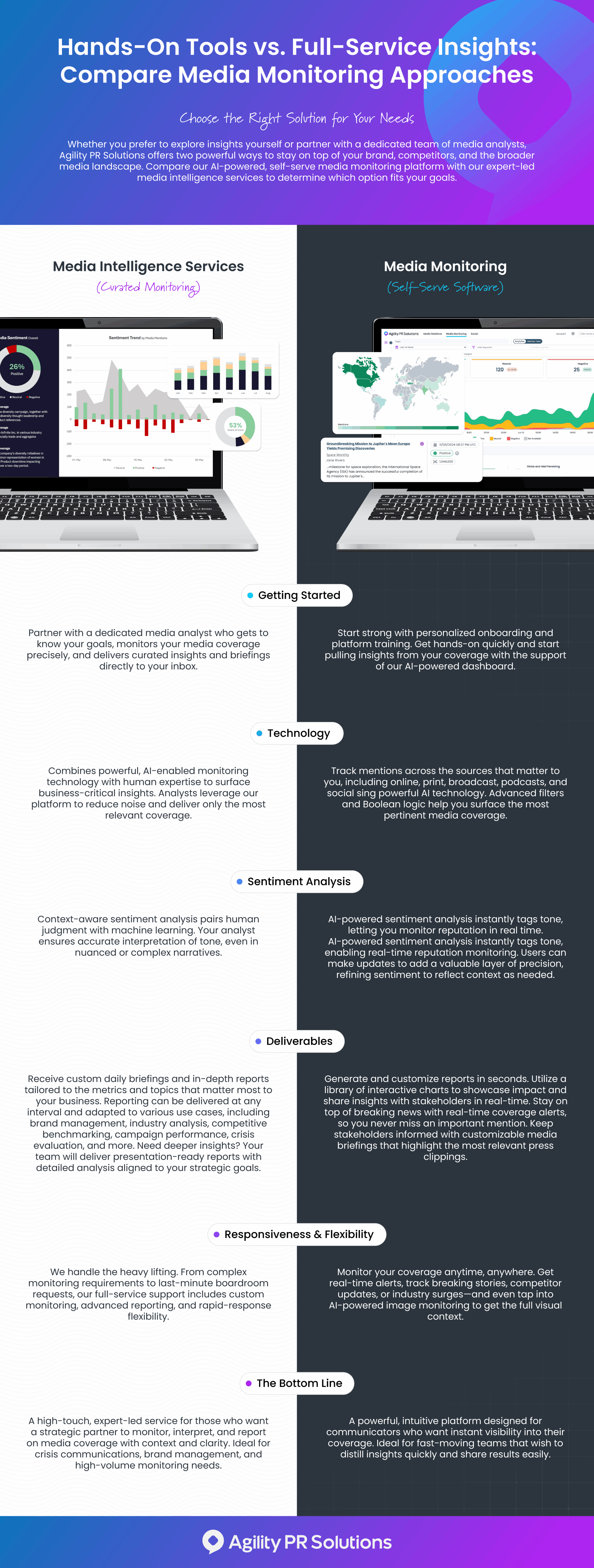
Comparing providers
If you’ve been shopping around for a media monitoring tool or service, you’ve already heard of the 800-pound gorillas in the industry. If you’ve been around for a while, you’ve probably spent your career hopping back and forth between the two – never being completely happy with either.
It’s no secret that there are some big players in the space, but before you decide on the right option, be sure to read reviews on sites like G2 Crowd – and compare the leading vendors.
Everyone has different preferences about the businesses they work with and the service they receive, so look around and make sure you find a service provider that fits with your priorities. Here at Agility PR Solutions we believe in a few things:
- Easy-to-use, intuitive tools. It has to be easy to set up and use. Ease of use makes the difference between a tool you’ll love to use, and one that’s a chore. If you’re a PR professional this is a quality of life issue.
- Quality support. If you need help, you want a vendor that is there for you. Plain and simple. At Agility PR Solutions, we know how important that is. That’s why we’ve added live chat to our platform – so we’re there to answer your questions, and make sure our tools are working exactly as they should so you never have to worry.
- Sharing is caring. We make it simple to collect your coverage into virtual clipbooks that you can easily share with colleagues or clients who need to be kept in the loop.
- Doing business together should be easy. We love our customers, and it shows – because they love us too! Check reviews, and run for cover if providers won’t even post their pricing information.
- It’s not just the coverage that matters. We include sentiment analysis so you can tell at a glance whether a mention is positive or not.
- Images are important. We’re the first and only company to include AI-powered image search in a media monitoring tool, so you can go beyond text-only results and understand even more about the context of your coverage.
- You need some specific information included. We include details that make it easy to tell your story, such as share of voice and coverage over time. Best of all, it’s dead simple to paste these charts and tables into the reports you’re sharing with your colleagues, boss, board, etc.
So maybe we’re bragging, but it’s only because we think you’re the best and want to make a good impression [blushing].
Whether you’re just starting out, or looking to make a switch, the good news is that the best media monitoring providers make sure you can jump right in without missing a beat.
At least that’s our commitment to you…
With superb on-boarding packages, attentive account executives, reliable support, and the promise of a superior product and service, there’s really nothing to be worried about.
We’re proud of how we serve our clients and hope you’ll consider doing business with us!
Ready to optimize your media monitoring workflows? Speak to one of our experts.
Frequently Asked Questions
What is media monitoring, and why is it important?
Media monitoring is the practice of tracking, analyzing, and managing mentions of your brand, competitors, industry, or key topics across various media channels – including news, social, print, and broadcast. It’s essential for reputation management, understanding public sentiment, measuring campaign impact, and staying ahead of risks and opportunities.
What’s the difference between media monitoring and social listening?
Media monitoring captures mentions across traditional and digital media to inform PR strategy. Social listening, a subset of media monitoring, focuses specifically on tracking conversations, engagement, and sentiment across social media platforms. Together, they provide a comprehensive view of public perception.
What media channels should I monitor?
A comprehensive media monitoring strategy revolves around the following key channels:
- Online news for real-time media cycles
- Social media for audience sentiment and viral content
- Print for prestige placements and regional visibility
- Television broadcast for mass-market influence
- Radio broadcast for accessing remote demographics
- Podcasts for niche thought leadership
- Blogs and forums for community-driven conversation
Your preferred monitoring channels should align with where your target audience and stakeholders consume content.
How do I choose the right media monitoring tool?
Look for tools that offer:
- Multi-channel coverage (news, print, social, broadcast, etc.)
- Commitment to innovation – incorporates the latest measurement and monitoring trends
- Real-time alerts and sentiment analysis
- Custom reporting and dashboards
- Scalable pricing and reliable support
If needed, consider fully managed services with human-augmented analysis for high-stakes use cases.
What metrics should I track in a media monitoring report?
Key metrics include:
- Volume of mentions across channels and over time
- Sentiment breakdowns by media type, geography, and outlet
- Share of voice vs. competitors
- Top-performing coverage by reach or engagement
- Spokesperson mentions and key message pickup
Tailored metrics help align reports with internal goals and stakeholder needs.
How do I track competitors using media monitoring?
Use keyword tracking to monitor competitor names, spokespeople, products, and campaigns. This helps you benchmark share of voice, identify their earned media wins or missteps, and adapt your messaging accordingly. Monitoring competitors also reveals which journalists are covering your space.
Can media monitoring help measure PR ROI?
Yes. Media monitoring links your coverage to key metrics, including audience reach, engagement, and share of voice. By tracking campaign performance and media pickups over time, PR pros can demonstrate ROI and refine strategy based on what actually works.
Can media monitoring help during a PR crisis?
Absolutely. Real-time alerts (based on keywords, sentiment, surges in volume, etc.) allow you to catch emerging threats early. During a crisis, media monitoring helps:
- Track sentiment shifts and misinformation
- Monitor how your response is received
- Identify advocates or detractors
- Adjust messaging on the fly
It’s essential for controlling the narrative and rebuilding trust.
How does AI improve media monitoring?
Agility leverages AI to empower PR teams through:
- Enabling granular sentiment analysis by entity and audience detection
- Offering predictive insights through intelligent dashboards
- Identifying key takeaways and in-depth insights
- Suggesting relevant keywords to ensure comprehensive tracking
Agility’s PR CoPilot suite exemplifies these AI features in action.



